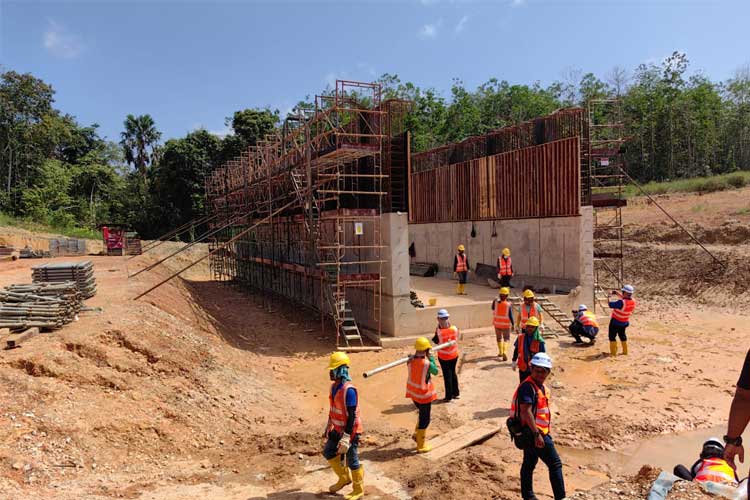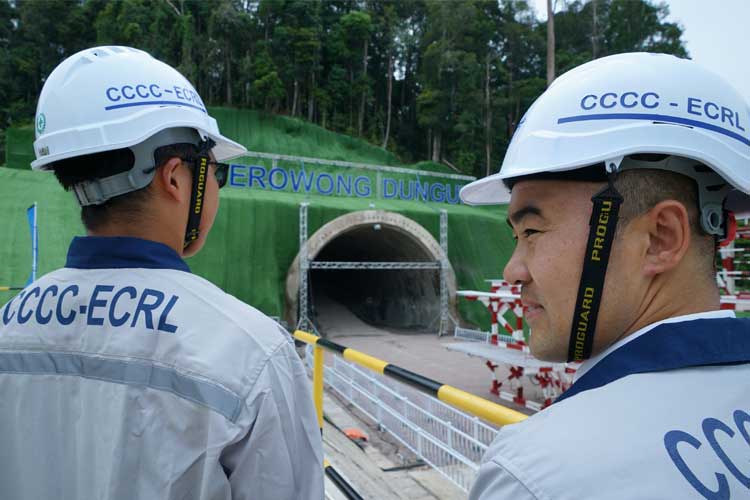
By Alan Ting
KOTA KINABALU, Malaysia: Snaking across Peninsula Malaysia as it links Port Klang, Malaysia's biggest transport hub, and Kuantan Port, which faces the South China Sea, East Coast Rail Link (ECRL) infrastructure project forms a "land bridge” that bypasses Singapore and is integral to China's Belt and Road Initiative (BRI).
The cost of the 665km railway has been the most problematic aspect: RM74. 96 billion including its construction cost of RM50. 27 billion, and development costs amount to RM24 billion but there have been higher estimates. Critics have warned that the country faces heavy debts over the next 30-years for the construction of a project that whose economic viability is questionable at best.
Officials have admitted that it will not turn a profit and its finance and construction along with Malaysia's heavy dependence on China as a trade partner, disproportionate in comparison with any other Southeast Asia country, has given the latter a huge amount of leverage over Malaysia through several governments, raising questions over its sovereignty and independence.
Deforestation and impact on wildlife

The Titiwangsa Mountain Central Region located at the Pahang-Selangor-Negeri Sembilan borders is a mega-biodiversity region that needs to be preserved but the ECRL's pathway from the East Coast to West Coast cuts through many areas deemed environmentally sensitive including forest reserves, rivers and roaming grounds for a variety of wildlife and Orang Asal who depend on these areas.
While many attempts have been made on how ECRL seeks to reduce the impact on the vast tropical jungles that cover Pahang and other states, the fact is there is little to no challenge on the validity of the various environmental impact assessments done on the project. No comprehensive information has been made available on how many trees have to be cut down, the impact of siltation in rivers as a result of loss of forest cover and the flooding and landslides that are increasingly common in areas affected by the ECRL's construction.
The critically-endangered Malayan Tiger, elephants and tapirs are just some of the animals that will be affected. Despite the construction of "wildlife crossings" that resemble concrete drains that are likely to become clogged due to flood debris connecting the now fragmented forest and wildlife roaming grounds, it is yet to be seen if the animals will simply avoid the crossings due to electrical interference from ECRL infrastructure including signals, lights and noises.
Naturally the clearing of these areas makes them even more accessible to poachers and others involved in the illegal wildlife trade, ironic as the main end destination of trafficked animals and their parts is China, the very party that is overseeing the destruction of Malaysia's forest cover.
Displacement of communities

Naturally the scope and scale of the ECRL also means that like animals, people too will be displaced. While this has been less of a headache for those behind the ECRL in the less developed and populated East Coast states of Kelantan, Terengganu and Pahang, the densely populated and much more prosperous state of Selangor is where major problems lay.
Residents of Desa Mukmin Warisan, a village on the outskirts of Kuala Lumpur (located wholly inside Selangor) have been asked to vacate their homes with the government planning to demolish 100 homes to make way for the tracks. The villages have complained at the abrupt manner of their eviction, being given only 20 days and little compensation.
“The lack of transparency and public engagement is rooted in the way the government treats these megaprojects – as huge acts of benevolence, by promising massive developments in rural Malaysia that will greatly benefit all,” Benjamin Loh, a senior lecturer at Taylor’s University was reported saying. Others have echoed his sentiments adding that these evictions and many more that are expected, will cost the government dearly in terms of image and political support.
While the Pakatan Harapan (PH) coalition has long held power in the state, the poor handling of evictions have made the reassurances by Selangor chief minister Amirudin Shari seem to ring hollow, with the usual ambiguous and non-committal lines being thrown around: "This requires relocation of some residents, who have raised objections...We will talk to them to find a win-win solution," he said.
Economic viability

While the harm done to the land, wildlife and people is bad enough, ultimately the project may end up being nothing but a huge debt hanging over Malaysia's future as the country struggles to repay loans it has taken out to build the project. Not only will it take jobs away from logistics providers such as long-haul truckers and the downstream businesses that cater to them, it will fail to create the jobs that both China and local politicians are claiming ECRL will generate.
Independent consultant P Gunasegaram noted that: "At RM55 billion, it’s the largest infrastructure project ever for Malaysia. If we assume a required 10 percent rate of return on the investment, the ECRL has to generate an income, not revenue, of RM5.5 billion a year. Assuming income is even 20 percent of revenue, then revenue needs to be a massive RM27.5 billion! The impossible task ahead is illustrated by this: In 2016, Singapore’s port had a turnover of S$3.7 billion (RM11.7 billion) and a profit of S$1.2 billion."
“The ECRL’s cost benefit calculations have not been convincing and consistent in long-term best returns for the country [Malaysia], especially given the high costs both in [terms of financial drain] and in the potential implications in the geopolitical and security spheres,” Collins Chong Yew Keat, from the University of Malaya observed.
Failed job creation

Tied to the lacklustre economic expectations of the project, ECRL was touted as being a major job creator. With claims ranging from 19,000 to 88,000 jobs being created, there has been to date little if any information on the jobs being created. Even Chinese officials based in Malaysia cautiously claim 4,000 jobs have been created but little is known on whether this number includes substantial numbers of Malaysians or those from Bangladesh and China, with the former employed for dirty, dangerous and demeaning tasks while China nationals serve as technicians, engineers and other specialist roles.
As far as it is known Malaysians are employed in administrative or otherwise inconsequential roles, providing little opportunity to develop local talent in the railway sector. Several major Malaysian firms and supplies have benefited from their proximity to those involved in the project, supplying raw materials such as sand and concrete and in the timber sector but this can hardly be considered "job creation" especially not in the promised railway sector.
"However, seven years after construction, there is little progress in the way of job creation. In fact there is a disturbing “wall of silence” over this issue. There is no readily available information that will clarify this, neither from the Human Resource Ministry nor the builders of the ECRL itself," wrote political economic & international relations analyst Samirul Ariff Othman.
Dancing to Beijing's tune

Despite the controversy and obvious problems, the ECRL has had no shortage of supporters from Malaysia's political class. Whether Barisan Nasional (BN), Pakatan Harapan (PH), Perikatan Nasional (PN) or the current Unity Government led by Prime Minister Anwar Ibrahim, all have sought to talk up the ECRL as a major driver of growth for Malaysia but ignore and suppress the critical questions raised.
China is determined to draw Southeast Asian states into its orbit, especially through infrastructure projects, not only in Malaysia but Laos and Indonesia, literally having these countries sign away their economic independence, subverting themselves to Beijing and its desire to use the region as part of its aggressive plans to increase its influence and control.
The negative impact of China's predatory debt trap, especially in relation to the BRI is well documented and understood:
"Laos is struggling to repay the billions it borrowed from China to fund the hydroelectric dams, trains and highways, which have drained the country of foreign reserves. As repayments drag, external debt is rising, a vulnerability exacerbated by the pandemic and rising global fuel and food prices," reported the Washington Post.
ECRL may end up being a symbol of China's physical presence and control in Malaysia but it is not too late to act. Being a sovereign state Malaysia must enforce its own interests including guaranteeing the promised transfer of railway technology, job creation and adequate compensation for the loss of forest cover and the displacement of wildlife and people who are in the way of the ECRL's destructive path.
Malaysia must ensure that it is China, as the instigator and prime mover of ECRL, bears the economic and political risks and not the Malaysian public, who neither want nor need this soon to be white elephant.








0 Comments
LEAVE A REPLY
Your email address will not be published